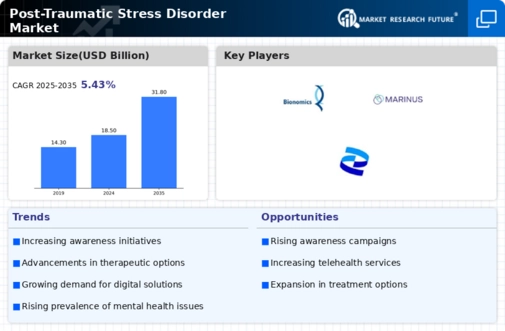Major market players are spending a lot of money on R&D to increase their product lines, which will help the market of post-traumatic stress disorder to grow even more. Market participants are also taking a range of strategic initiatives to grow their worldwide footprint, with key market developments such as new product launches, contractual agreements, mergers and acquisitions, increased investments, and collaboration with other organizations. Competitors in the Post-Traumatic Stress Disorder industry must offer effective drugs or medications to expand and survive in an increasingly competitive and rising market environment.
One of the primary business strategies adopted by manufacturers in the Post-Traumatic Stress Disorder industry to benefit clients and expand the market sector is to develop and introduce drugs that helps in effective treatment. In recent years, Post-Traumatic Stress Disorder industry has provided medicine with some of the most significant benefits. The Post-Traumatic Stress Disorder market major player such as Mylan NV (US), Greenstone LLC (US), Bionomics (Australia), Tonix Pharmaceuticals Holding Corp. (US), Marinus Pharmaceuticals Inc. (US), Azevan Pharmaceuticals (US), Lundbeck A/S (Denmark), and others are working to expand the market demand by investing in research and development activities.
Bionomics Ltd operates as a clinical-stage biopharmaceutical company. The Company focuses on developing a pipeline of novel therapeutic ion channel targeting drug candidates to improve the lives of patients suffering from central nervous system (CNS) disorders. Bionomics serves customers in Australia. In November 4, 2019, Bionomics limited, a clinical-stage biopharmaceutical company, announced that the U.S. Food and Drug Administration (FDA) granted Fast Track designation to the BNC210 development program for the treatment of post-traumatic stress disorder (PTSD) and other trauma-related and stressor-related disorders..
Also, The goal of Tonix, a clinical-stage biopharmaceutical firm, is to find, acquire, licence, and develop therapies to treat, prevent, and lessen pain in humans. Tonix's product pipeline includes candidates for the central nervous system (CNS), uncommon diseases, immunology, and infectious diseases. Small molecules and biologics for the treatment of pain, neurologic, psychiatric, and addiction problems are included in Tonix's CNS portfolio.
TNX-102 SL1 is a potential treatment for a group of individuals with Long COVID syndrome, and Tonix Pharmaceuticals, Inc., a clinical-stage biopharmaceutical company, reported in August 2022 that the first patient has been enrolled in the Phase 2 PREVAIL study of this drug. As a daily bedtime medication for Long COVID, fibromyalgia, PTSD, alcohol use disorder, and agitation in Alzheimer's disease, TNX-102 SL is currently undergoing clinical testing.


















Leave a Comment